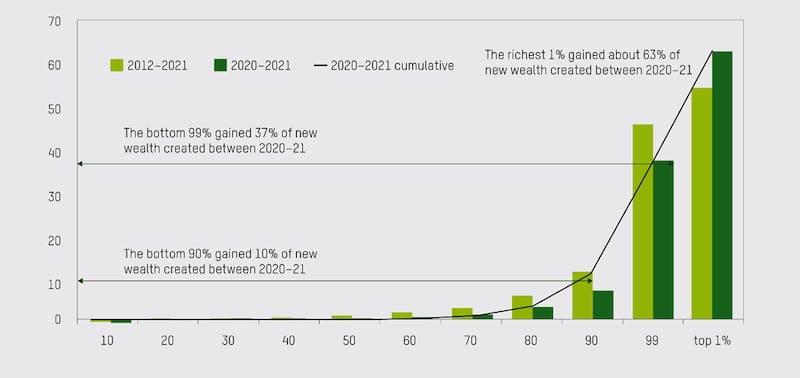The ranks of Ireland’s super-rich have swollen in the past decade, a new study by Oxfam Ireland has revealed, with the wealthiest 1 per cent of the population accumulating 70 times more wealth than the bottom 50 per cent since 2012.
In Ireland, the number of people with individual wealth of more than $50 million (€46.6m) has surged, more than doubling from 655 to 1,435 people between 2012 and 2022.
It means that for every $100 of wealth created in the period, $34 has gone to the richest 1 per cent, with less than 50c going to the bottom 50 per cent. The figures, drawn from data from Forbes, Credit Suisse and Wealth-X, indicate that Ireland’s wealthiest 1 per cent have out-earned the bottom half by more than 70 times since 2012, when the Irish economy slowly began to emerge from the post-2008 recession.

Timed to coincide with the start of the World Economic Forum – which begins today in Davos, Switzerland – the charity’s Survival of the Richest publication highlights the stark contrast in fortunes between the world’s wealthiest and poorest over the past 10 years.
READ MORE
Oxfam’s report also indicates that at a combined €15 billion, Ireland’s two richest people have more wealth than the 50 per cent of the population at the other end of spectrum, who have a combined €10.3 billion.
Although they are not named in the report, Ireland’s two wealthiest people, according to the Forbes 2022 rich list, are Stripe billionaires Patrick and John Collison, who are estimated to have a combined €17.5 billion fortune.
[ Stripe enters 30-day consultation with staff over job cutsOpens in new window ]
The next wealthiest Irish person on the list is Lone Star Funds chairman John Grayken, with an estimated net worth of close to €6 billion.
Until last year, Ireland’s wealthiest individual was Indian-born engineering billionaire Pallonji Mistry, who was worth an estimated €13.8 billion at the time of his death last June aged 93.
Oxfam Ireland chief executive Jim Clarkin said: “This rising wealth at the top and rising poverty for the rest are two sides of the same coin, proof that our economic system is functioning exactly how the rich and powerful designed it to. It was 10 years ago when we first sounded the alarm about extreme inequality at the World Economic Forum and yet since then the world’s billionaires have almost doubled their wealth. As crisis after crisis hits the poorest people hardest, it’s time for governments, including Ireland’s, to tax the rich.”
Mr Clarkin said a tax on Irish wealth at graduated rates of 2 per cent, 3 per cent and 5 per cent above a threshold of €4.7 million would raise €8.2 billion annually.
This has “the potential to transform Irish public services in health, housing and education while also delivering on our international and climate commitments”, he said.
The case for taxing wealth globally was clear, Mr Clarkin said, given that Amazon founder Jeff Bezos, the world’s richest man with a personal fortune of more than €157 billion, “paid a ‘true tax rate’ of just 1 per cent from 2014 to 2018″.
“Oxfam believes an international approach to taxing the super-rich is needed and we are calling for governments to introduce both permanent wealth taxes and temporary windfall taxes,” he said.













